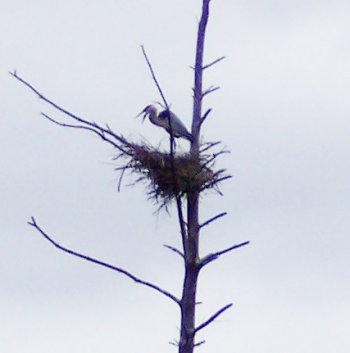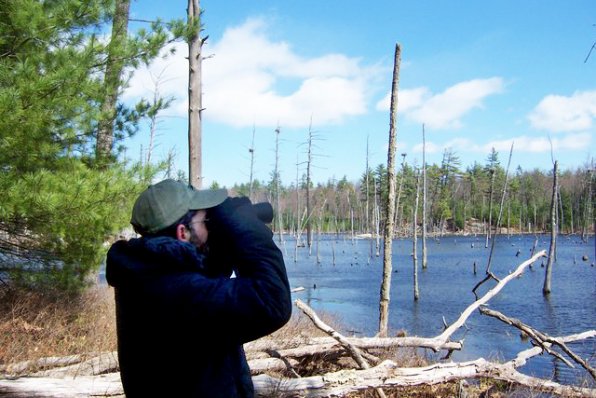This past winter while I was hiking through the woods northeast of Concord, I discovered a remote beaver pond with several large nests high in some dead trees in the middle of the pond. I later mentioned this to Kevin Wall, director of Nature Education for the New Hampshire Audubon Society, and he said, “That sounds like the site of a great blue heron rookery.” He added, “Let's go there later this spring. By mid-March, the great blue herons should be back from the south.” So during the second week of spring, Wall and I made the one-hour trek back to that isolated pond. What we found was indeed a very active great blue heron rookery.
As we approached the edge of the pond, several of the large birds, with blue-gray plumage, floated up into the air on their majestic deep wing-beats and slowly circled over the pond appearing to investigate our intrusion into their serene environment. Looking through binoculars, we could see that five of the nests were each occupied with a great blue heron standing guard. We thought that maybe some of the nests had eggs being incubated by an adult bird whose head was barely visible above the nest.
The nests of great blue herons seem to be very flimsy and loosely built, but they are used year after year with any necessary repair work being done by the nesting pair. Typically, the male brings in extra sticks and the female weaves them in place.
The three to five blue-green eggs in each nest will hatch in about 28 days of incubation. The young will stay in the nest for two months as both parents are kept busy feeding the nestlings. For another two weeks after leaving the nest the fledglings will continue to be fed by the adults.
Great blue herons, the most common and widely distributed herons in North America, are conspicuous for their long legs, long neck and long sharp bill. They have a wingspan of almost 6 feet and they stand over 3 feet tall. In flight their neck is folded in a serpentine “S” shape while their stilt-like legs trail straight back.
You might see a great blue heron standing motionless in shallow water patiently waiting for a fish or frog to come within striking distance. Then with lightning speed its head pierces the water and comes up with a squirming fish in its bill.
The great blue heron's call, which it seldom makes, is a hoarse guttural “kraak” that Henry Thoreau said “is anything but musical.” However, feeding time at the nest can be very noisy with the excited young squabbling for food. That is when the adult herons appear to murder their young as they thrust their bills into the throats of their hungry offspring with regurgitated food.
Wall and I plan to revisit the rookery later in early June. We hope to be there at feeding time.
Related content:























